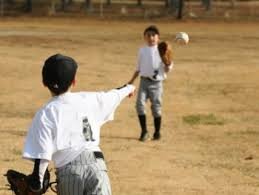Catching Principals
Catching a ball is a lifelong skill for a youth athlete. This developmental process starts as early as four years old. Catching any kind of ball applies to virtually every other sport in the world. Here are some principles that should be implemented when teaching a child how to catch a baseball.
Where should the hands be when catching?
When you are catching a baseball/softball it is important to understand where your hands should be. When you are tossing a ball to your players, make sure their hands adjust to where the ball has been thrown.
The hands for catching should be broken down into three pillars:
I like to breakdown where to catch the ball into three pillars. One is below the belly button, at the chest and above the eyes.
1) If the ball is tossed below the belly button the student’s palm should be facing the sky, as if you were cupping your hands for water. This is important because there is a tendency for students to turn their palms down and drop a ball.
2) When a baseball is thrown at a players chest, make sure they are showing you the inside of their palms with a diamond shape out in front. When a players hands are out in front, it will all them to catch the ball more easily if it is thrown hard to them. Lastly, make sure their throwing hand is underneath the glove.
3) When catching a ball in the air, make sure two hands stay at eye level. It will make this easier for the younger players to keep their hands steady. A great cue is “high five the sky” and “steady hands or strong hands”.
Drills for where to catch a ball for the youth ball players!
1) Bounce Catch Drill (ages 4-7 years old): Players can start this drill as young as six years old. The bounce catch drill is used for hand eye coordination. This can be used in a stationary position meaning players can do this with a ball being still or while moving around the field. This drill should be done individually. Make sure your players understand to bounce the ball with their throwing hand and catch it at the highest point possible. This can be done with a glove or without.
2) Right hand/Left Hand Toss (ages 4-7 years old): Have your players stand with their own ball and stay in a stationary position. Have them focus on tossing the ball from one hand to the other (without a glove). Sometimes a glove can be a distraction. Have your players focus on their eyes constantly watching the ball. This can also be done with players roaming within their own personal space, which will develop spatial awareness and body control.
3) Clap Catch Drill (ages 6-8 years old): Players will find their own area and focus on clapping their hands once and then catch the ball at the highest point, ideally above their eyes. This should be done WITHOUT a glove. This focuses on hand eye coordination, spatial awareness and increases focus.
4) Partner Catch (ages 6-12 years old): As players get more confidence and gain skills to catch a ball individually, partner catch can be very useful. A couple of pointers for when you partner up players to have a catch.
Assign receivers to designated areas. Cones, poly spots, and the foul line on a field is a way to keep players on track and organized. Having baseballs fly all over the place creates chaos and distracts other players from getting their practice in.
Confirm the receiver is giving the proper target. If the partner's glove is not open; the thrower will not get the proper target.
Make your players understand that they need to move to go catch the ball. A lot of times players think the throw needs to be right at them to try and catch the ball, which is not true. Tell your players they need to be prepared for the worst throw possible so they can adjust by jumping, diving and kneeling.


